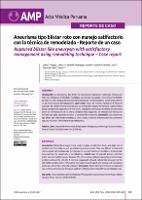| dc.contributor.author | Vargas Urbina, John F. | |
| dc.contributor.author | Rodriguez Varela, Rodolfo | |
| dc.contributor.author | Ordinola Cruz, Osmar | |
| dc.contributor.author | Saal Zapata, Giancarlo | |
| dc.date.accessioned | 2023-11-28T04:31:19Z | |
| dc.date.available | 2023-11-28T04:31:19Z | |
| dc.date.issued | 2022-09-20 | |
| dc.identifier.citation | Acta Médica Peruana. 2023; 39(3). | es_PE |
| dc.identifier.uri | https://hdl.handle.net/20.500.12959/4555 | |
| dc.description.abstract | Introducción: Los aneurismas tipo blíster son aneurismas pequeños, complejos, menores de 3mm, con alta tasa de morbilidad y mortalidad, así como de resangrado y recurrencia. Son difíciles de tratar y se han propuesto técnicas microquirúrgicas y endovasculares, siendo estas últimas las de menor tasa de complicaciones. Caso Clínico: Mujer de 74 años, ingresa con 6 horas de evolución de trastorno de sensorio brusco. La tomografía muestra hemorragia subaracnoidea difusa a predominio izquierdo. Se le realiza una angiografía cerebral que evidencia un aneurisma blíster de la trifurcación de la arteria cerebral media izquierda. Se emboliza con técnica de remodeling y coils, logrando obliterar la totalidad del aneurisma. Conclusión: Los aneurismas tipo blíster son aneurismas complejos y raros, siendo la terapia endovascular una alternativa segura y eficaz con menor tasa de complicaciones. | es_PE |
| dc.description.abstract | Introduction: Blister-like aneurysms are small, complex, smaller than 3mm, with high rate of morbidity and mortality, as well as rebleeding and recurrence. They are difficult to treat and microsurgical and endovascular techniques are current treatment modalities. Endovascular technique has the lowest rate of complications. Clinical case: 74-year-old woman, admitted with 6 hours of sudden sensory disorder. The CT scan shows diffuse subarachnoid hemorrhage predominantly on the left side. A cerebral angiography showed a blister-like aneurysm of the left middle cerebral artery trifurcation. The patient was treated with coiling and remodeling technique, achieving a complete occlusion. Conclusion: Blister-like aneurysms are complex and rare, whereas endovascular therapy is a safe and effective alternative with low complication rate. | es_PE |
| dc.format | application/pdf | es_PE |
| dc.language.iso | spa | es_PE |
| dc.publisher | Colegio Médico del Pérú | es_PE |
| dc.relation.uri | https://amp.cmp.org.pe/index.php/AMP/article/view/2381 | es_PE |
| dc.rights | info:eu-repo/semantics/openAccess | es_PE |
| dc.rights.uri | https://creativecommons.org/licenses/by-nc-sa/4.0/ | es_PE |
| dc.subject | Aneurisma intracraneal | es_PE |
| dc.subject | Embolización terapéutica | es_PE |
| dc.subject | Hemorragia subaracnoidea | es_PE |
| dc.subject | Arteria Cerebral Media | es_PE |
| dc.subject | Intracranial aneurysm | es_PE |
| dc.subject | Embolization Therapeutic | es_PE |
| dc.subject | Subarachnoid Hemorrhage | es_PE |
| dc.subject | Middle Cerebral Artery | es_PE |
| dc.title | Aneurisma tipo blister roto con manejo satifactorio con la técnica de remodelado - Reporte de un caso | es_PE |
| dc.title.alternative | Ruptured blister like aneurysm with satisfactory management using remodeling technique – Case report | es_PE |
| dc.type | info:eu-repo/semantics/article | es_PE |
| dc.subject.ocde | https://purl.org/pe-repo/ocde/ford#3.02.25 | es_PE |
| dc.identifier.doi | https://doi.org/10.35663/amp.2022.393.2381 | |






